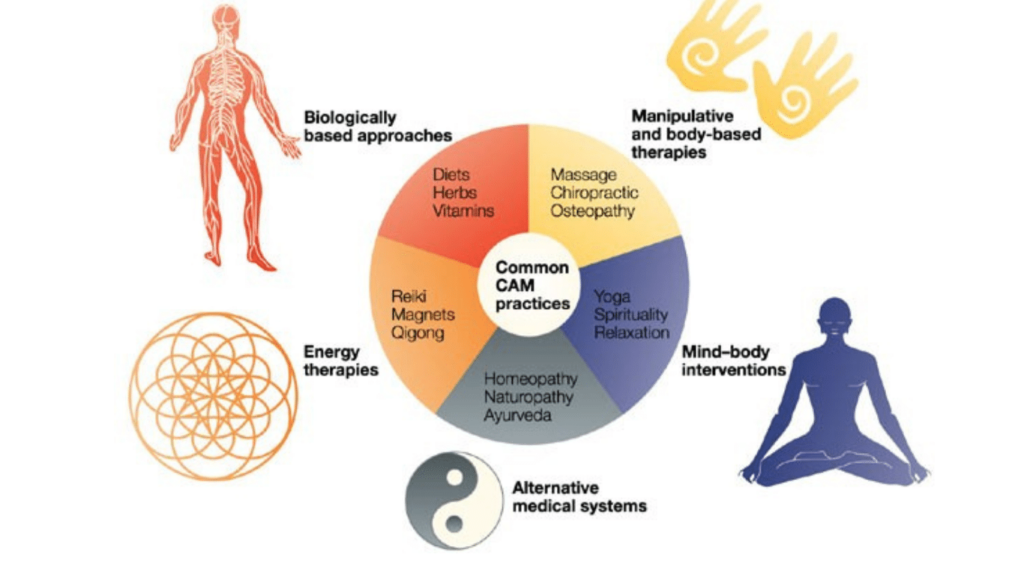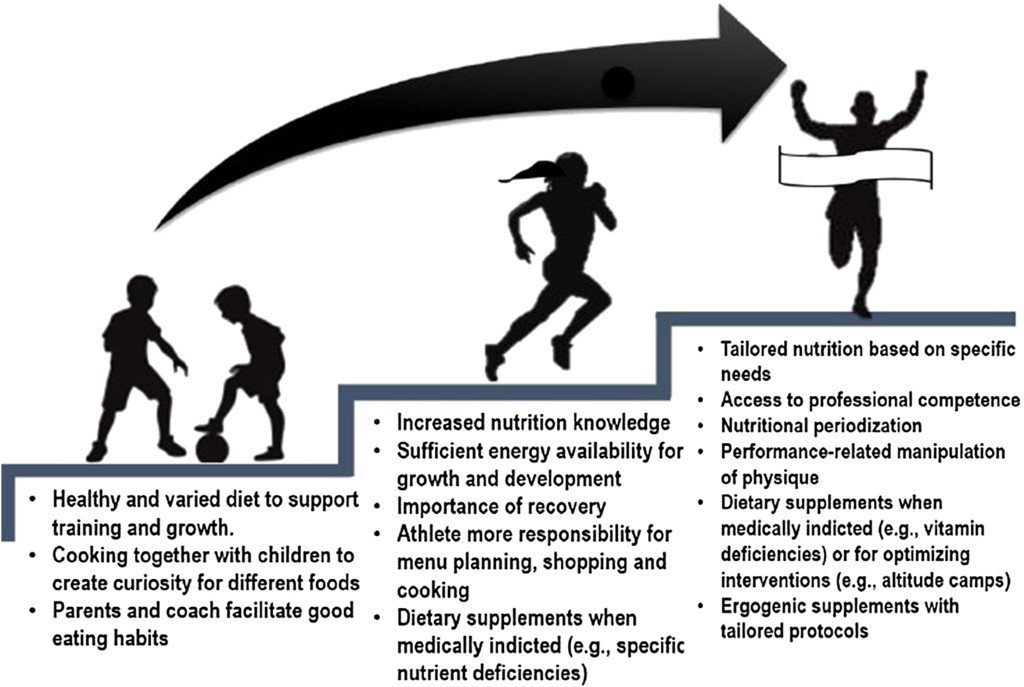Complementary and alternative treatment options are approaches used alongside other medicinal treatments, though they may be used to replace them in rare circumstances. The U.S. National Institutes of Health created the National Center for Complementary and Alternative Medicine (NCCAM) to foster research, innovation, and education related to these types of treatments, which span a large range of modalities that tend to fall into several broad categories including meditation, massage therapy, natural products like vitamins and minerals, Mind-Body techniques like yoga or Tai Chi and acupuncture along with Traditional Chinese Medicine (TCM).
Integrative medicine is the combination of mainstream medicine and alternative medical practices that are used in rehabilitation. Alternative practices have been around for a long time and many have not been studied much, but CAM treatments can be helpful.
CAM therapies fall into the following five categories:
- Alternative medical systems that are built upon comprehensive systems of theory and practice;
- Mind-body interventions, which include various methods to enhance the mind’s ability to influence bodily functions and symptoms;
- Biotherapy using natural substances such as herbs, foods and vitamins;
- Manipulative and body-based therapies, which are treatment methods based on manipulation and/or movement of one or more parts of the body;
- Energy therapy using the energy field includes biofield therapy and bioelectromagnetic therapy.

Alternative Medical Systems
Alternative medical systems offer unique approaches to healing that may be different from concepts taught in conventional medicine programs. The intent of most people who use alternative medicinal practices is to create a positive effect on human health, and the role of alternative treatments should be kept in context. Some forms of alternative medicine (such as homeopathy ) generated by cultures quite different than our own have the advantage of extensive histories , which makes it more difficult for critics to disprove their efficacy. Alternative medicines can vary due to distinct cultural reasons and varying political environments that make it difficult to identify whether or not they are effective, but critics debate what constitutes “evidence-based” alternative medicine given the absence of randomized controlled trials .
Chiropractic
Many people who suffer from common musculoskeletal problems aren’t ready to give up on the idea of traditional medicine, pills and even invasive procedures. This is why chiropractic is such a good option for some people suffering from back and neck pain caused by workplace injuries or car accidents. Chiropractors can work with patients to form a comprehensive treatment plan that will see them through their recovery process without having to use any chemical medications. In many cases they’re able to get people back on their feet quicker, despite several treatments over the course of their recovery.
Osteopathic Medicine
Osteopathic medicine is considered a part of traditional allopathic practice, however there are some differences. In general Osteopathy uses manual therapies to treat disease, as opposed to prescription medicines and surgery. Many Osteopaths also stress preventative health care, similar to primary care physicians in the US.
Homeopathy
Homeopathy is an alternative medicine based on the theory of downgrading. Samuel Hahnemann, the founder of homeopathy, believed that while high levels of a substance might be incredibly toxic, it may cure in small quantities. The principle of like curing like has its origin in many ancient practices including modern day Chinese traditional medicine which suggests that for instance bleeding yourself can relieve headaches. These theories are not at all scientifically backed up which does not mean one should completely rule out the essence that “like cures like”. For example there is some scientific backing to the very fact that allopathic (or conventional) medicine derived from plants and healing herbs by diluting them into non-toxic products with very much potent results. There only needs to be a little bit of such revelation to help understand that nature’s wisdom goes far beyond humans and hence it should never be criticized or belittled by any means but rather accepted as it comes.
Naturopathy
These are highly trained, licensed professionals that use all sorts of means to treat and promote health. They will take a look at every individual, their lifestyles and their environment to determine the best course of action to deal with each issue because treatment varies on a case-by-case scenario. One thing that is significant about Naturopaths is that they have so many different specialities within the field – ranging from pediatrics, sports, women’s health, geriatrics, athletics, lifestyle and behavioral changes so you can address the specific areas of your concern and not just one thing where their scope of practice comes in really handy. In fact they deal with all types of ailments be it physical or emotional as well as natural remedies for general health problems and illnesses.
Ayurveda
According to the principles of Ayurveda, everything in the universe is made up of three basic elements and a combination of numerous other energies. In order for any living being to be a healthy being (both physically and mentally), it is important that these energy are kept in balance. To achieve that, we will be talking about basically what each major element represents, how they interact with one another and how to preserve a balanced energy
Mind-Body Therapies
Mind-body practices have been used for thousands of years to treat a wide variety of ailments, many with very positive results. One specific mind-body practice that has been gaining popularity over the past few decades began in 1979 when Jon Kabat-Zinn first introduced his “Mindfulness Based Stress Reduction Program”.
Cognitive-Behavioral Therapy
Cognitive-behavioral therapy has been included in health insurance company packages for years. Although used commonly as a complementary and alternative medical practice, it has recently moved into the mainstream of conventional medical practices due to its success in treating a range of ailments including insomnia, fibromyalgia, headaches, pain, and low back pain.
Meditation
Meditation is the mental exercise of focusing on a specific idea or thing. It has many different names depending upon the goal of the person who does it, for example mindfulness, breathing techniques like pranayama, and mantra recitation which uses a specific sound (in Hinduism). The results of meditation are health-related as well as psychological. Some believe that meditation can cure diseases. They also say that by doing this everyday you clear your mind and it helps in your daily challenges such as finding more time to do things. Meditating needs patience and dedication to be able to achieve its benefits such as relaxation, weight loss, stress reduction and anti-aging effects.
Expression- and Art-Based Therapies
Art therapy, defined by the American Art Therapy Association in 1975 as “the use of creative art-making within a professional relationship and for purposes that are therapeutic,” is used to specifically target individual’s mental health. The main idea behind using art therapy is to help one express themselves through the ways they create or manipulate their artwork. It can also be used to help one deal with physical issues involved in making their artwork as well as emotional ones. For example, someone may have trouble expressing emotion verbally but not when they’re making art; this helps them express their emotions without having to worry about being judged or told they’re wrong. This field was included many types of therapeutic approaches so it can be help to range of people including those who cannot easily express thoughts and feelings verbally.
The American Art Therapy Association defines art therapy as the “therapeutic use of art making, within a professional relationship, by people who experience illness, trauma, or challenges in living, and by people who seek personal development.”4 It uses creative activities to help patients with physical and emotional problems. Proponents claim that both the creative process and the final work can help express and heal trauma. Patients can create paintings, drawings, sculptures, and other types of artwork, and can work individually or in groups. Art therapists typically have a master’s degree in art therapy or a related field. They help patients express themselves through the art they create. They also discuss emotions and concerns that patients might identify as they work on their art.
Biologically Based Therapies
Dietary supplements are not just for athletes. In fact, most research suggests that people with chronic conditions use complementary and alternative medicine therapies more often than those without such conditions. This means that it’s doubly important to have a working knowledge of herbal remedies especially as even patients with chronic conditions are more likely to be using dietary supplements like ginseng and chondroitin for example. We know that the number of supplements available is practically limitless so this article will focus on those supplements most likely to affect your work as a physiatrist, including ginseng which can help arthritis sufferers around the world. While the numbers vary from country to country, one study found that there are over 50 million Americans currently taking herbal products making dietary supplements one of the biggest markets in the United States today!
Select Dietary Supplements Frequently Encountered in Physical Medicine and Rehabilitation Practice

Chondroitin Sulfate
Evidence
Many studies have been conducted on chondroitin and glucosmine, and the results vary but most of them seem to indicate that these two supplements are modestly effective at relieving symptoms of osteoarthritis. The multicenter, double-blind, placebo- and celecoxib-controlled Glucosamine/chondroitin Arthritis Intervention Trial (GAIT) reported on 1583 patients with knee arthritis.42 Significant effects were seen in the subgroup of patients with the most severe pain, but not in those with lesser symptoms. Although it was reported as a “negative” trial, several concerns emerged after the study was reported, including that the placebo response was inexplicably high. Consequently there is still active debate about the proper role of these agents in the management of arthritis symptoms.
Adverse Effects
Toxicity is not nearly as big of an issue here as it is when it comes to other substances or illegal narcotics, since this experience usually doesn’t include hallucinations or significant mood changes. The main concern is gastrointestinal, where subjects will report nausea and epigastric discomfort.
Glucosamine Sulfate
Evidence
Osteoarthritis is a condition affecting the cartilage in the joints, causing pain, swelling and stiffness. Glucosamine sulfate has been evaluated for managing osteoarthritis (OA) of the knee and to reduce symptoms of OA. Local studies have suggested benefits equal to certain non-steroidal anti-inflammatory drugs (NSAIDs). However, FDA conclusions from these same studies suggest that glucosamine sulfate works no better than placebo.
Adverse Effects
Stomach aches, nausea, heartburn and diarrhea are not uncommon symptoms for people who suffer from MySpace addiction. But I hear that most of the time these symptoms are usually self-limited and rarely require discontinuation.
The Dietary Supplement Health and Education Act of 1994 created a new category of supplements known as “dietary supplements.” They are regulated differently from OTC drugs, but still don’t enjoy the same regulations as foods. This means that they’re “not to be consumed or ingested by humans except under the supervision of a healthcare professional,” according to the FDA.5 (5) Because dietary supplement products may not put up warning labels or even sell information on side effects, consumers are at times unaware of the dangers inherent in using them. The 2007 FDA rule regulating GMPs has been enacted so far only in the context of domestic production facilities and will apply to imported products beginning in 2010; this will provide a more uniform standard for quality control than was previously available.
Manipulation and Body-Based Therapies
Therapies that feature the manipulation of physical elements are among the most important when it comes down to healing. It’s not surprising then that there are a number of different forms of manipulative treatments which can be employed together to provide a truly holistic approach to treatment and prevention.
